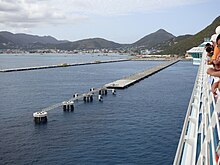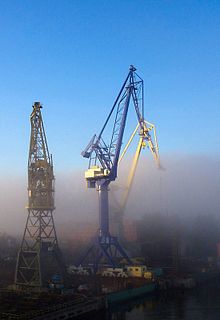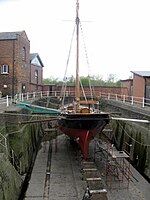
A harbor, or harbour, is a sheltered body of water where ships, boats, and barges can be moored. The term harbor is often used interchangeably with port, which is a man-made facility built for loading and unloading vessels and dropping off and picking up passengers. Harbors usually include one or more ports. Alexandria Port in Egypt is an example of a harbor with two ports.

A wharf, quay, staith, or staithe is a structure on the shore of a harbour or on the bank of a river or canal where ships may dock to load and unload cargo or passengers. Such a structure includes one or more berths, and may also include piers, warehouses, or other facilities necessary for handling the ships. Wharves are often considered to be a series of docks at which boats are stationed. A marginal wharf is connected to the shore along its full length.

Lothal was one of the southernmost sites of the ancient Indus Valley civilisation, located in the Bhal region of the Indian state of Gujarat. Construction of the city is believed to have begun around 2200 BCE.

A dry dock is a narrow basin or vessel that can be flooded to allow a load to be floated in, then drained to allow that load to come to rest on a dry platform. Dry docks are used for the construction, maintenance, and repair of ships, boats, and other watercraft.

A mooring is any permanent structure to which a seaborne vessel may be secured. Examples include quays, wharfs, jetties, piers, anchor buoys, and mooring buoys. A ship is secured to a mooring to forestall free movement of the ship on the water. An anchor mooring fixes a vessel's position relative to a point on the bottom of a waterway without connecting the vessel to shore. As a verb, mooring refers to the act of attaching a vessel to a mooring.

A pier is a raised structure that rises above a body of water and usually juts out from its shore, typically supported by piles or pillars, and provides above-water access to offshore areas. Frequent pier uses include fishing, boat docking and access for both passengers and cargo, and oceanside recreation. Bridges, buildings, and walkways may all be supported by architectural piers. Their open structure allows tides and currents to flow relatively unhindered, whereas the more solid foundations of a quay or the closely spaced piles of a wharf can act as a breakwater, and are consequently more liable to silting. Piers can range in size and complexity from a simple lightweight wooden structure to major structures extended over 1,600 m (5,200 ft). In American English, a pier may be synonymous with a dock.
A floating dock, floating pier or floating jetty is a platform or ramp supported by pontoons. It is usually joined to the shore with a gangway. The pier is usually held in place by vertical poles referred to as pilings, which are embedded in the seafloor or by anchored cables. Frequently used in marinas, this type of pier maintains a fixed vertical relationship to watercraft secured to it, independent of tidal, river or lake elevation. The angle of the gangway varies with the water level.

Bristol Harbour is the harbour in the city of Bristol, England. The harbour covers an area of 70 acres. It is the former natural tidal river Avon through the city but was made into its current form in 1809 when the tide was prevented from going out permanently. A tidal by-pass was dug for 2 miles through the fields of Bedminster for the river, known as the "River Avon New Cut", "New Cut", or simply "The Cut". It is often called the Floating Harbour as the water level remains constant and it is not affected by the state of the tide on the river in the Avon Gorge, The New Cut or the natural river southeast of Temple Meads to its source.

Saint Peter Port Harbour is located in Saint Peter Port, Guernsey. It was a natural anchorage used by the Romans which has been changed into an artificial harbour that is now the island's main port for passengers. Loose cargo, liquids and gas are shipped to and from St Sampson's harbour.

In boating, a fender is an air-filled ball or a device in other shape and material used to absorb the kinetic energy of a boat or vessel berthing against a jetty, quay wall or other vessel. Fenders, used on all types of vessels, from cargo ships to cruise ships, ferries and personal yachts, prevent damage to vessels and berthing structures. To do this, fenders have high energy absorption and low reaction force. Fenders are typically manufactured out of rubber, foam elastomer or plastic. Rubber fenders are either extruded or made in a mold. The type of fender that is most suitable for an application depends on many variables, including dimensions and displacement of the vessel, maximum allowable stand-off, berthing structure, tidal variations and other berth-specific conditions. The size of the fender unit is based on the berthing energy of the vessel which is related to the square of the berthing velocity.

Netham Lock is the point at Netham in Bristol at which boats from the River Avon, acting as part of the Kennet and Avon Canal, gain access to Bristol's Floating Harbour.

The Port of Hull is a port at the confluence of the River Hull and the Humber Estuary in Kingston upon Hull, in the East Riding of Yorkshire, England.
A berth is a designated location in a port or harbour used for mooring vessels when they are not at sea. Berths provide a vertical front which allows safe and secure mooring that can then facilitate the unloading or loading of cargo or people from vessels.

The Port of Southampton is a major passenger and cargo port located in the central part of the south coast of England. It has been an important port since the Roman occupation of Britain nearly two thousand years ago, and has a multifaceted history. From the Middle Ages to the end of the 20th century, it was a centre for naval shipbuilding and a departure point for soldiers going to war. The port also played a role in the development of hovercraft, flying boat services, seaplanes and the Spitfire fighter plane. Before the advent of jet travel, Southampton was Britain's gateway to the world. The port also played a minor role in the history of Britain's canals.
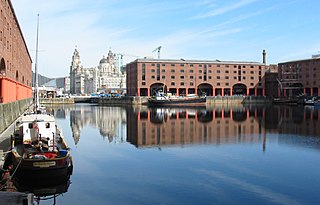
A floating dock, floating harbour or wet dock is a dock alongside a tidal waterway which maintains a 'constant' level, despite the changing tides.
Wadi al-Jarf is an area on the Red Sea coast of Egypt, 119 km (74 mi) south of Suez, that is the site of the oldest known artificial harbour in the world, developed about 4500 years ago. It is located at the mouth of the Wadi Araba, a major communication corridor between the Nile Valley and the Red Sea, crossing the Eastern Desert. The site is across the Gulf of Suez from the small Sinai fortress of Tell Ras Budran. A somewhat similar ancient port is at Ain Sukhna, a little north of Wadi al-Jarf.

Haldia Port, officially Haldia Dock Complex (HDC), is a port on the river bank of the confluence of the Haldi River and the Hooghly River. The port is located on the west bank of the Hooghly River at Haldia in West Bengal, about 121 km from the deep sea (sandheads), 45 kilometres (28 mi) upstream from Pilotage Station and 104 km downstream of Kolkata. It developed in independent India in the 1960s, and officially began operations in 1977 as an associate port of the Port of Kolkata. The dock system of the port consists of a lock and riverside jetties. Haldia port mainly handles fully loaded Handy size –carriers of 28,000–40,000 DWT–vessels; but the port has a maximum draft depth of 9 metres (30 ft) and can accommodate Panamax vessels up to 230 metres (750 ft) long with 40-50-percent cargo parcels.

Sydney Cove West Archaeological Precinct is a heritage-listed precinct that contains The Rocks police station, the Museum of Contemporary Art Australia, car park, parks, shops and roads located at 112–156 George Street, in the inner city Sydney suburb of The Rocks in the City of Sydney local government area of New South Wales, Australia. The precinct previously contained a commissariat store, Maritime Services Board offices, dockyard and Department of Labour & Industry offices. Buildings in the precinct were developed in various stages since 1797 to date, with heritage-listed buildings dating from 1797 to 1939. The precinct is also known as the Museum of Contemporary Art, Maritime Services Board, Colonial Government naval dockyard, Commissariat Stores, Colonial Hospital, Kings and Queens Wharf and First Fleet Park. The property is owned by Property NSW, an agency of the Government of New South Wales. It was added to the New South Wales State Heritage Register on 5 August 2011.
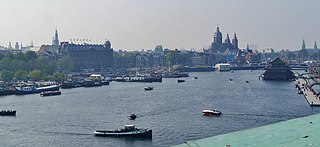
The Oosterdok is a former wet dock in Amsterdam. It was created in 1831-1832 by constructing the Oosterdoksdam and the Oosterdoksluis, forming a reliable deep port closed off from the tidal IJ.
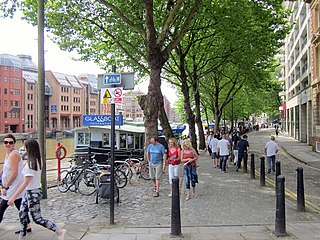
Welsh Back is a wharf and street alongside the floating harbour in the centre of the city of Bristol, England. The wharf and street extend some 450 metres (1,480 ft) along the west side of the harbour between Bristol Bridge and Redcliffe Bridge. At the northern end, the street and wharf are immediately adjacent, but to the south they are separated by a range of single story transit sheds. The wharf is a grade II listed structure and takes its name because it was freqented by vessels from Welsh ports.
